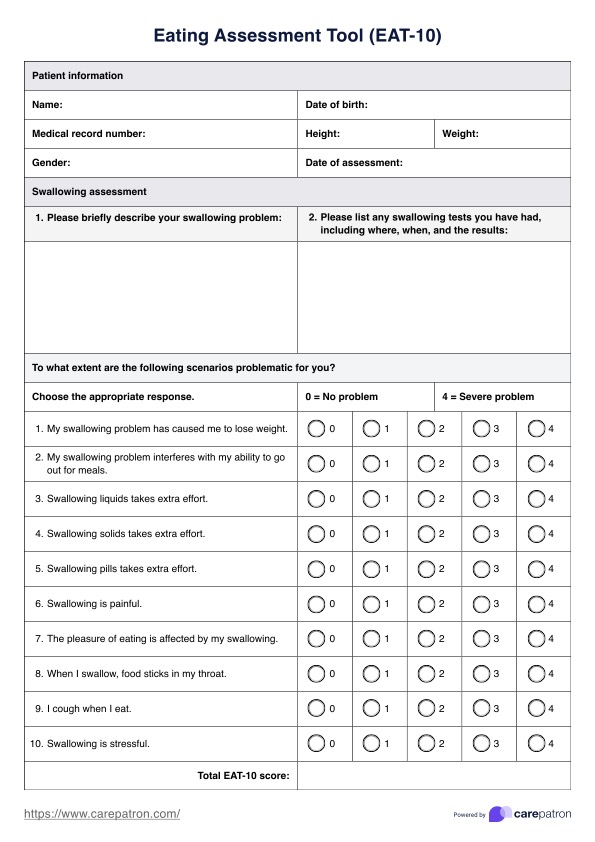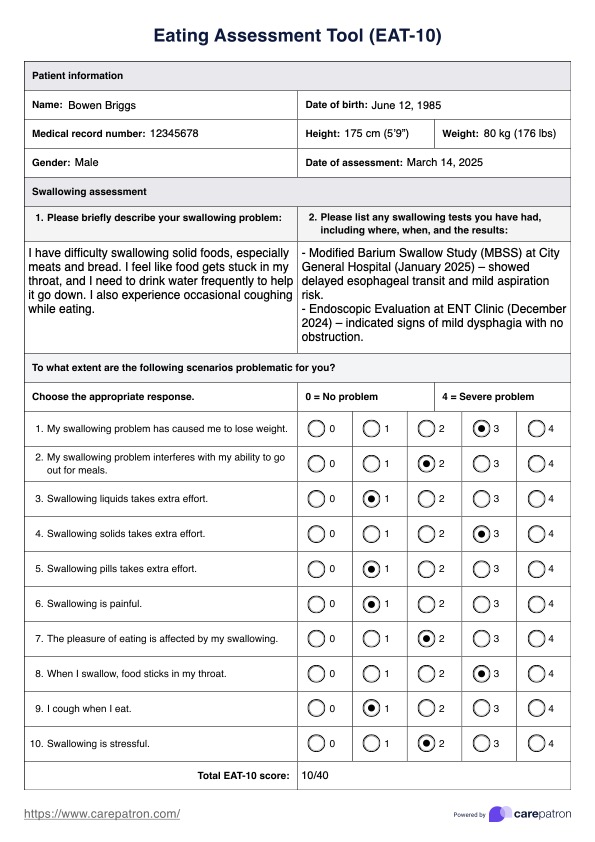EAT-10
Download Carepatron's free Eating Assessment Tool-10 (EAT-10) PDF and effectively assess dysphagia risk or other swallowing disorders.


What is EAT-10?
The eating assessment tool-10 (EAT-10) is a validated screening tool used by healthcare professionals to assess swallowing disorders and their severity. It is a self-administered assessment tool consisting of ten questions that evaluate swallowing function, including difficulty with liquids, solids, and medications.
Together with fiberoptic endoscopic examination, EAT-10 is commonly used in the clinical evaluation of patients with head and neck cancer, acute stroke patients, and individuals with neurological or structural impairments affecting swallowing (Florie et al., 2020). It helps clinicians identify predict aspiration risk and determine the need for further diagnostic testing or intervention. Additionally, it is utilized to assess swallowing function in patients with reflux or voice disorders, where dysphagia symptoms may indicate underlying esophageal dysfunction.
This assessment tool is widely applied in hospitals, rehabilitation centers, and outpatient clinics, aiding healthcare providers in developing targeted treatment plans. As a reliable and efficient screening measure, EAT-10 facilitates early detection of swallowing difficulties and helps guide appropriate clinical decision-making for at-risk populations.
EAT-10 Template
EAT-10 Example
How does the EAT-10 swallowing screening tool work?
EAT-10 is one of the structured screening tools designed for healthcare professionals to evaluate swallowing disorders efficiently. By following a standardized approach, clinicians can assess dysphagia severity, predict aspiration risk, and determine appropriate interventions. Using Carepatron's EAT-10 template, practitioners can streamline the assessment process and ensure accurate documentation.
Step 1: Access the assessment template
To begin, click the "Use template" button on this page. You will be redirected to Carepatron’s app, where you can access the digital EAT-10 assessment tool. This ensures that all patient evaluations are securely stored and easily retrievable for future reference or follow-up assessments. You can also download a PDF version by choosing "Download."
Step 2: Use the template in patient assessment
Open the EAT-10 assessment tool and fill in patient details. This includes demographics, medical history, and any prior swallowing evaluations. Having a structured template ensures consistency in documentation and helps streamline clinical workflows, making the assessment process more efficient for both clinicians and patients.
Step 3: Conduct the assessment
Administer the EAT-10 questionnaire by having the patient self-report their swallowing difficulties. The assessment consists of ten key questions, each rated on a 0 to 4 scale, evaluating the severity of swallowing impairments. Ensure the patient understands each question and provide clarification if needed while maintaining standardized administration.
Step 4: Gather and interpret results
Calculate the total EAT-10 score to determine the severity of dysphagia. A score ≥3 suggests clinically significant swallowing impairment. Document findings to support clinical decision-making and determine if further diagnostic testing or intervention is necessary.
Step 5: Provide patient support and next steps
Based on the assessment results, discuss potential next steps with the patient. If necessary, refer them for further evaluation, such as a videofluoroscopic swallow study (VFSS) or fiberoptic endoscopic evaluation of swallowing (FEES). Offer guidance on dietary modifications, swallowing therapy, or medical interventions to manage oropharyngeal dysphagia effectively.
Scoring and interpretation
The EAT-10 is a validated dysphagia screening tool designed to quantify swallowing difficulties and guide clinical decision-making. Each question is scored on a Likert scale from 0 (no problem) to 4 (severe problem), with a total score ranging from 0 to 40. The EAT-10 shows excellent reliability and validity, with a score of 3 or higher indicating abnormal swallowing function. It is useful for assessing dysphagia severity and monitoring treatment progress across different swallowing disorders (Belafsky et al., 2008).
In clinical practice, the EAT-10 is widely used among diverse populations, including community-dwelling older adults, stroke survivors, and patients with neurological conditions. It helps healthcare professionals determine whether additional testing is necessary for a more comprehensive assessment.
Benefits of using this assessment tool
The EAT-10 provides healthcare professionals with a standardized swallowing screening tool to evaluate dysphagia efficiently in a clinical setting. It offers a quick and reliable method to determine initial dysphagia severity, allowing for early identification of patients at risk for complications such as aspiration pneumonia and malnutrition.
This dysphagia assessment enhances clinical screening guiding appropriate referrals for further testing such as flexible endoscopic evaluation or videofluoroscopy. By integrating the eating assessment into routine evaluations, clinicians can streamline workflows, reduce assessment time, and improve patient management.
The tool also improves diagnostic accuracy, particularly in patients with neurological disorders, stroke, or head and neck cancer, by providing quantifiable data for monitoring progression and treatment response. Its structured format ensures consistency in documentation and facilitates communication between multidisciplinary teams, optimizing patient care and treatment planning.
References
Belafsky, P. C., Mouadeb, D. A., Rees, C. J., Pryor, J. C., Postma, G. N., Allen, J., & Leonard, R. J. (2008). Validity and reliability of the eating assessment tool (EAT-10). Annals of Otology, Rhinology & Laryngology, 117(12), 919–924. https://doi.org/10.1177/000348940811701210
Florie, M., Pilz, W., Kremer, B., Verhees, F., Waltman, G., Winkens, B., Winter, N., & Baijens, L. (2020). EAT‐10 scores and fiberoptic endoscopic evaluation of swallowing in head and neck cancer patients. The Laryngoscope, 131(1). https://doi.org/10.1002/lary.28626
Commonly asked questions
EAT-10 stands for eating assessment tool-10, a validated dysphagia screening tool used to assess swallowing difficulties and their impact on a patient’s quality of life. It consists of ten self-reported questions that help quantify swallowing disorders and determine the need for further clinical evaluation.
Yes, the EAT-10 has strong psychometric properties, demonstrating high reliability and validity across diverse patient populations. It is widely used in clinical practice for its accuracy in identifying oropharyngeal dysphagia severity and predicting aspiration risk.
Oropharyngeal dysphagia involves difficulty starting a swallow due to structural, anatomic, or neuromuscular issues, while esophageal dysphagia occurs after swallowing from structural problems, external compression, or motility disorders.











































































































